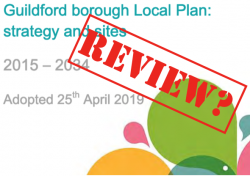 Abraham Lincoln
If given the truth, the people can be depended upon to meet any national crisis...
Abraham Lincoln
If given the truth, the people can be depended upon to meet any national crisis...
 Guildford news...
for Guildford people, brought to you by Guildford reporters - Guildford's own news service
Guildford news...
for Guildford people, brought to you by Guildford reporters - Guildford's own news service
Letter: Local Plan Review Requires Fresh Thinking
Published on: 26 Nov, 2023
Updated on: 26 Nov, 2023
 From: David Roberts
From: David Roberts
In response to: Scope of Mandatory Local Plan Review To Be Considered
I am sorry to see the R4GV leader trot out the old canard (repeated so often by the Tories and Lib Dem Cllr George Potter) that a meaningful review of the Local Plan risks producing a higher, rather than lower, housebuilding target [Scope of Mandatory Local Plan To Be Considered]. The so-called “Standard Method” for calculating housing is not mandatory and should not spook anyone.
More broadly, it would be better it if all party leaders could make clear what, ideally, they want the outcome of a Local Plan review to be. Otherwise, it’s going to be the usual whitewash.
If a party went into a national election pledging only to review existing policy, and not to change it, they would never get elected. The Local Plan review is not a technical exercise and councillors are not elected to be led by the nose by council officers and lawyers. They are there to make up-front political choices and set clear directions.
Everyone agrees that the Tory Local Plan is defective – even, finally, the Tories. But no-one (except I hope the Guildford Greenbelt Group) seems prepared to say what changes they want.
The Tories argue implausibly that their perfect creation has been undermined by unforeseen factors. But The Dragon’s archives show that all these factors – including the lack of infrastructure provision and the inflated population projections and housing need figures – have been explained in painful detail to them ever since they foisted the first draft of the plan on us in 2013.
Since the plan, almost unaltered from that first draft, was adopted in 2019, Brexit, Covid, Ukraine and the cost-of-living crisis have merely compounded its founding flaws.
The Tories didn’t listen, and now seem to be nursing a forlorn hope that we’ve all forgotten who introduced the plan and the undemocratic way it was rammed through.
The Lib Dems (whose then leader shamefully voted with the Tories to adopt the Plan) are scarcely better. They have no known policy on local planning and would much rather the whole thing go away. There is perhaps a [Cllr] Potter policy, but we don’t know its status since the council and Lib Dem leader appears to have taken Trappist vows on anything relating to council business.
For five years in office, the Lib Dems have prevaricated about reviewing the plan and would not review it now were this not mandatory. They would much prefer to carry on as we are, hiding behind whatever technical evidence the bureaucrats choose to spoon-feed them and the excuse (which gets thinner as a general election approaches) that the council is bound and gagged by an unfeeling government.
The Lib Dem group may have persuaded itself that the public don’t care about the plan, even though many of the gripes they hear on the doorstep – about traffic congestion, the lack of affordable housing, poor public transport, and overstretched social and physical infrastructure – are often the plan’s fault.
This should worry both the LibDem and Tory parliamentary candidates since, in recent local elections, over-development in the north-east of the borough has seen about 10,000 votes desert their parties in favour of local ones. The threat of an extra 2,200 houses on green fields at Wisley is just one local issue here.
So please let’s see some party manifestos for the Local Plan review that frees planning in Guildford from the dismal nexus of big housebuilders, professional consultants and planning officers. For inspiration, I suggest:
Recent Articles
- Guildford Institute’s Crowdfunding Project for Accessible Toilet in its New Community and Wellbeing Centre
- Letter: Guildford – Another Opportunity Missed?
- Letter: GBC’s Corporate Strategy – Where Is the Ambition?
- My Memories of John Mayall at a Ground-breaking Gig in Guildford Nearly Six Decades Ago
- Westborough HMO Plans ‘Losing the Heart of the Street’ Says Resident
- College Invests to Boost Surrey’s Economy and Close Digital Skills Gap
- Community Lottery Brings Big Wins for Local Charities
- GBC Housing Plan Promises ‘A Vibrant Urban Neighbourhood’ Near Town Centre
- Hospital Pillows ‘Shortage’ at the Royal Surrey
- Updated: Caravans Set Up Camp at Ash Manor School


Search in Site
Media Gallery
Dragon Interview: Local Artist Leaves Her Mark At One of England’s Most Historic Buildings
January 21, 2023 / No Comment / Read MoreDragon Interview: Lib Dem Planning Chair: ‘Current Policy Doesn’t Work for Local People’
January 19, 2023 / No Comment / Read MoreA3 Tunnel in Guildford ‘Necessary’ for New Homes, Says Guildford’s MP
January 10, 2023 / No Comment / Read More‘Madness’ for London Road Scheme to Go Ahead Against ‘Huge Opposition’, Says SCC Leader
January 6, 2023 / No Comment / Read MoreCouncillor’s Son Starts Campaign for More Consultation on North Street Plan
December 30, 2022 / No Comment / Read MoreCounty Council Climbs Down Over London Road Works – Further ‘Engagement’ Period Announced
December 14, 2022 / No Comment / Read MoreDragon Interview: GBC Reaction to the Government’s Expected Decision to Relax Housing Targets
December 7, 2022 / No Comment / Read MoreHow Can Our Town Centre Businesses Recover? Watch the Shop Front Debate
May 18, 2020 / No Comment / Read More









Recent Comments